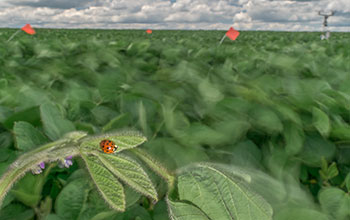Multimedia Gallery
Multicolored Asian lady beetle in wind-blown soybean field
An Asian lady beetle (harmonia axyridis) rests on a plant in a soybean field in this time-exposed image. New research suggests that diminishing wind speeds caused by climate change affect the ability of such insects to capture prey.
Rising temperatures and shifting precipitation patterns may get the bulk of climate change attention, but predators may want to give some thought to wind, according to a University of Wisconsin-Madison zoologist's study, which is among the first to demonstrate the way "global stilling" may alter predator-prey relationships.
As the Earth continues to warm, wind speeds in the Midwest are expected to decline as much as 15 percent during the 21st century. In America, the trend across the landscape is to put up barriers to the wind in the form of buildings and more natural structures. University of Wisconsin Madison zoologist Brandon Barton is studying how changes in wind speed may affect the Asian lady beetle's ability to catch prey.
Lady beetles feed on soybean aphids--tiny insects that hug plants and anchor themselves while feeding with a needle-like mouthpart called a stylet. They are a major pest for soybean plants. For his research, Barton grew plots of soybeans in alfalfa fields and protected some with wind blocks and left others in the open. He found the plots that were hidden from the wind had two-thirds more lady beetles and the plants that grew in the open had twice as many soybean aphids.
"The aphids appear on the plants whether it's windy or not, and we showed that in lab experiments," said Barton. "But when you add the predators, with the wind block, the beetles eat something like twice as many aphids."
But, Barton adds, "How do you do your duty as a predator if you're entire world is moving around? If the plant is moving, it takes four times as long for the predator to start eating, and it eats less than half as many aphids in an hour."
Slower natural wind speeds could reduce the amount of pesticide required to keep soybean aphids from wrecking harvests. And the wind research may present other opportunities for pest control. "By growing trees or not harvesting them around a field, you may be able to have an indirect effect on the number of aphids on your soybean plants," Barton said. The results of this study make him question what other close animal relationships may be disrupted by shifting winds.
This research was funded by the National Science Foundation (NSF) through grant DEB 12-40804.
To learn more, see the NSF News From the Field story Dwindling wind may tip predator-prey balance. (Date of Image: July 2014)
Credit: Brandon T. Barton, University of Wisconsin-Madison
See other images like this on your iPhone or iPad download NSF Science Zone on the Apple App Store.
Images and other media in the National Science Foundation Multimedia Gallery are available for use in print and electronic material by NSF employees, members of the media, university staff, teachers and the general public. All media in the gallery are intended for personal, educational and nonprofit/non-commercial use only.
Images credited to the National Science Foundation, a federal agency, are in the public domain. The images were created by employees of the United States Government as part of their official duties or prepared by contractors as "works for hire" for NSF. You may freely use NSF-credited images and, at your discretion, credit NSF with a "Courtesy: National Science Foundation" notation.
Additional information about general usage can be found in Conditions.
Also Available:
Download the high-resolution JPG version of the image. (1.3 MB)
Use your mouse to right-click (Mac users may need to Ctrl-click) the link above and choose the option that will save the file or target to your computer.



